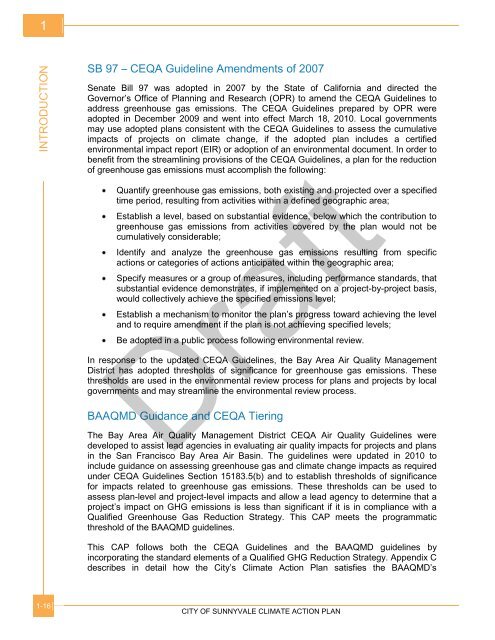DRAFT Climate Action Plan - PMC
DRAFT Climate Action Plan - PMC
DRAFT Climate Action Plan - PMC
You also want an ePaper? Increase the reach of your titles
YUMPU automatically turns print PDFs into web optimized ePapers that Google loves.
1<br />
INTRODUCTION<br />
SB 97 – CEQA Guideline Amendments of 2007<br />
Senate Bill 97 was adopted in 2007 by the State of California and directed the<br />
Governor’s Office of <strong>Plan</strong>ning and Research (OPR) to amend the CEQA Guidelines to<br />
address greenhouse gas emissions. The CEQA Guidelines prepared by OPR were<br />
adopted in December 2009 and went into effect March 18, 2010. Local governments<br />
may use adopted plans consistent with the CEQA Guidelines to assess the cumulative<br />
impacts of projects on climate change, if the adopted plan includes a certified<br />
environmental impact report (EIR) or adoption of an environmental document. In order to<br />
benefit from the streamlining provisions of the CEQA Guidelines, a plan for the reduction<br />
of greenhouse gas emissions must accomplish the following:<br />
Quantify greenhouse gas emissions, both existing and projected over a specified<br />
time period, resulting from activities within a defined geographic area;<br />
Establish a level, based on substantial evidence, below which the contribution to<br />
greenhouse gas emissions from activities covered by the plan would not be<br />
cumulatively considerable;<br />
Identify and analyze the greenhouse gas emissions resulting from specific<br />
actions or categories of actions anticipated within the geographic area;<br />
Specify measures or a group of measures, including performance standards, that<br />
substantial evidence demonstrates, if implemented on a project-by-project basis,<br />
would collectively achieve the specified emissions level;<br />
Establish a mechanism to monitor the plan’s progress toward achieving the level<br />
and to require amendment if the plan is not achieving specified levels;<br />
Be adopted in a public process following environmental review.<br />
In response to the updated CEQA Guidelines, the Bay Area Air Quality Management<br />
District has adopted thresholds of significance for greenhouse gas emissions. These<br />
thresholds are used in the environmental review process for plans and projects by local<br />
governments and may streamline the environmental review process.<br />
Draft<br />
BAAQMD Guidance and CEQA Tiering<br />
The Bay Area Air Quality Management District CEQA Air Quality Guidelines were<br />
developed to assist lead agencies in evaluating air quality impacts for projects and plans<br />
in the San Francisco Bay Area Air Basin. The guidelines were updated in 2010 to<br />
include guidance on assessing greenhouse gas and climate change impacts as required<br />
under CEQA Guidelines Section 15183.5(b) and to establish thresholds of significance<br />
for impacts related to greenhouse gas emissions. These thresholds can be used to<br />
assess plan-level and project-level impacts and allow a lead agency to determine that a<br />
project’s impact on GHG emissions is less than significant if it is in compliance with a<br />
Qualified Greenhouse Gas Reduction Strategy. This CAP meets the programmatic<br />
threshold of the BAAQMD guidelines.<br />
This CAP follows both the CEQA Guidelines and the BAAQMD guidelines by<br />
incorporating the standard elements of a Qualified GHG Reduction Strategy. Appendix C<br />
describes in detail how the City’s <strong>Climate</strong> <strong>Action</strong> <strong>Plan</strong> satisfies the BAAQMD’s<br />
1-16<br />
CITY OF SUNNYVALE CLIMATE ACTION PLAN


